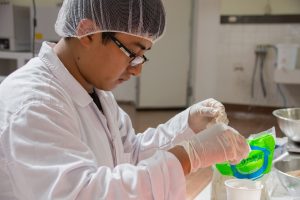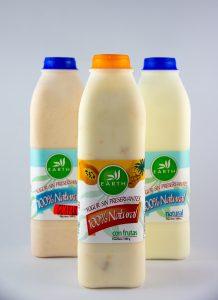A dairy plant for experiential learning
Many people say that EARTH University produces one of the best yogurts in Costa Rica. The reasons are abundant: it is a natural product without preservatives, made with milk produced in the Livestock Farm, and fresh fruit harvested from the educational farms on our Guácimo Campus. The flavor is as unique as the process and history behind each dairy product produced at EARTH. That list is long, including different types of cheeses like mozzarella and labneh, along with sweet cream, “dulce de leche” (milk candy), butter, infinite flavors of ice cream, and the acclaimed yogurt. Products change based on internal demands, new ideas by dairy plant officials and/or students, and the raw materials on hand. But one thing is clear: all the dairy products created are of the highest quality.
In 2007, USAID’s American Hospitals and Schools Abroad (ASHA) program donated the dairy plant, a teaching space where students can learn about the entire dairy production process, including marketing. Built that same year, the plant has a utensils storage room, a dairy maturation room, three refrigeration chambers, a raw materials warehouse, an office, a packaging material warehouse, and a milk analysis laboratory. The plant is part of the Food Processing Laboratory (LPA), where products such as chocolate, sausages, jams, sauces, and others are made, in addition to dairy products.
The dairy plant was ASHA’s third donation among 16 large investments that the program has made at EARTH. The grant was given to recognize and promote best practices in entrepreneurship shared between EARTH, USAID and U.S. citizens. Without a doubt, it is one of the most beneficial to our University’s academic program. Two tons of milk are received and processed per week to cover 92% of internal demand and consumption. This includes the cafeteria, where students and some staff and faculty dine, plus internal sales to residents and staff.
 “In addition to creating products for internal consumption, our main goal is to meet the needs of different courses, such as Food Processing, which studies dairy production and chemical analysis of products like cheese and yogurt, among other topics. It also covers the Business Project course, where second-year students share their projects with the LPA, for the business they have to create,” says Ivannia Sánchez, Head of the Academic Unit for Added Value. “For example, some groups base their business on creating ice cream, so they cover half of the campus demand and create new flavors. We support them at the plant with the raw materials and use of equipment. In addition, we collaborate with EARTH Futures and the Community Development Program to work with neighboring communities on projects related to the dairy industry.”
“In addition to creating products for internal consumption, our main goal is to meet the needs of different courses, such as Food Processing, which studies dairy production and chemical analysis of products like cheese and yogurt, among other topics. It also covers the Business Project course, where second-year students share their projects with the LPA, for the business they have to create,” says Ivannia Sánchez, Head of the Academic Unit for Added Value. “For example, some groups base their business on creating ice cream, so they cover half of the campus demand and create new flavors. We support them at the plant with the raw materials and use of equipment. In addition, we collaborate with EARTH Futures and the Community Development Program to work with neighboring communities on projects related to the dairy industry.”
 A wide variety of projects are being developed at the plant. For example, recent graduate José Woc (Class of 2021, Guatemala) investigated the manufacture and market valuation of three types of cheese: chevre, mozzarella, and gouda. One of José’s results was creating an impeccable recipe for gouda cheese, which Ivannia and other professors are now using to develop new blends: gouda with hibiscus, red wine, and coffee – ingredients all produced on the same campus. Presently, the cheese is maturing, and it will be a few months before we know the results of this promising experiment.
A wide variety of projects are being developed at the plant. For example, recent graduate José Woc (Class of 2021, Guatemala) investigated the manufacture and market valuation of three types of cheese: chevre, mozzarella, and gouda. One of José’s results was creating an impeccable recipe for gouda cheese, which Ivannia and other professors are now using to develop new blends: gouda with hibiscus, red wine, and coffee – ingredients all produced on the same campus. Presently, the cheese is maturing, and it will be a few months before we know the results of this promising experiment.
The dairy plant has been an impetus to foster experiential learning, knowledge sharing with communities, and creativity for everyone studying and working there. Thanks to ASHA’s donation, we can produce delicious yogurt, milk consumed by more than 500 people on campus, and cheeses with unexpected flavors.





